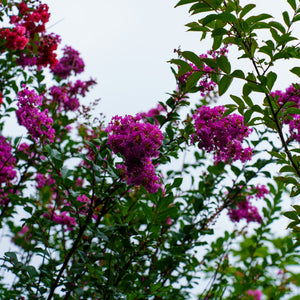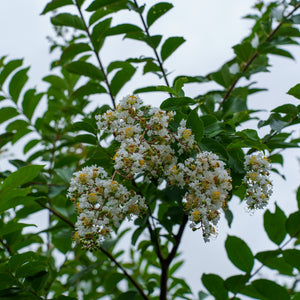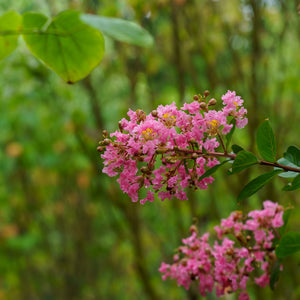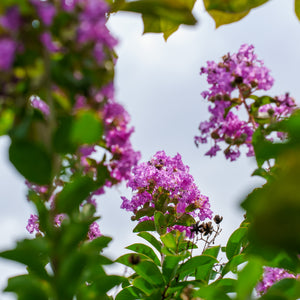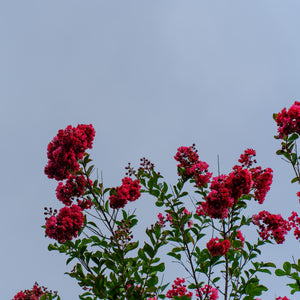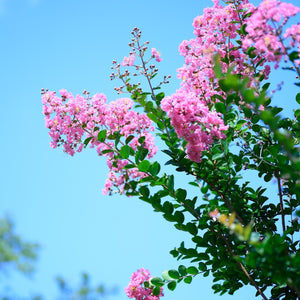The Crape Myrtle Guide
Crape Myrtle (Lagerstroemia spp.) is one of the most unique ornamental trees in American landscapes, admired for its vibrant summer blooms, attractive bark, and compact, sculptural form. Known for thriving in heat and humidity, this low-maintenance, high-impact tree is a staple in gardens across the South and increasingly popular in temperate regions nationwide. Its long flowering period and decorative year-round features make it a prized focal point for residential and public landscapes.
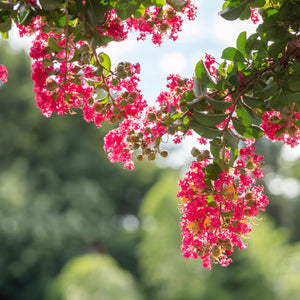
About
Native to Asia, Crape Myrtles belong to the Lagerstroemia genus, with Lagerstroemia indica and its hybrids being the most common in cultivation. These trees are widely known for their crinkled, crepe-like blooms that appear in midsummer and persist into fall. Colors range from pure white and pale pink to bold magenta, purple, and rich red. Many varieties also offer vibrant fall foliage and exfoliating bark in shades of cinnamon, tan, and gray.
Popular varieties include Lagerstroemia indica 'Catawba', with its deep purple blooms and compact shape, and Lagerstroemia indica 'Natchez', a widely planted white-flowering tree with smooth bark and an elegant form. For striking red tones, Lagerstromia indica 'Enduring Red' is a top pick, while Lagerstroemia x 'Powhatan' features soft lavender flowers and strong disease resistance.
These trees are highly adaptable to urban and suburban landscapes, with many cultivars ranging from 3-foot dwarf shrubs to 30-foot flowering trees. Crape Myrtles are heat-tolerant, drought-resistant once established, and offer multi-season beauty, making them ideal for mass plantings, privacy screens, or as a standout focal point in the garden.
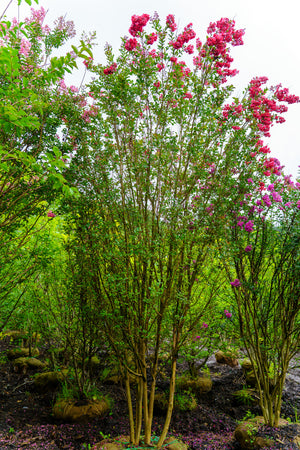
PLANTING
Crape Myrtles are easy to establish when planted properly. Choose a sunny location with well-drained soil for best results.
USDA Hardiness Zones: Most varieties thrive in Zones 7–9, though some cold-hardy cultivars like Lagerstroemia 'Sarah’s Favorite' can be grown in Zone 6 with protection.
Soil: Prefers well-drained soil enriched with organic matter. Slightly acidic to neutral pH is ideal. Avoid soggy conditions.
Sunlight: Full sun is essential for optimal flowering. At least 6 hours of direct sunlight ensures abundant blooms and healthy foliage.
Watering: Water regularly during the first year to establish roots. Once mature, crape myrtles are moderately drought-tolerant but benefit from deep watering during extended dry periods.
Spacing: Depends on the variety. Dwarf cultivars can be spaced 3–5 feet apart, while larger tree forms need 15–20 feet of clearance.
Planting Time: Plant in early spring or fall to avoid extreme temperatures. Container-grown trees can be planted anytime the ground is workable.
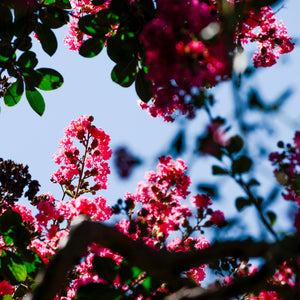
CARE
Crape Myrtles are low-maintenance but benefit from a few simple care practices to maximize their performance and appearance.
- Watering: Deeply water new plantings weekly until established. Mature trees need minimal supplemental watering.
- Fertilizing: Apply a slow-release, balanced fertilizer in early spring before new growth begins. Avoid high-nitrogen formulas that encourage leaves over flowers.
- Pruning: Prune in late winter or early spring to shape the tree and remove dead or crossing branches. Avoid "topping"—this damages the tree and reduces its natural beauty.
- Mulching: Apply a 2–3 inch layer of mulch to conserve moisture and reduce weeds, keeping it away from the trunk.
- Pests & Diseases: Generally disease-resistant, but susceptible to powdery mildew, aphids, or sooty mold in humid conditions. Choose resistant cultivars like Lagerstroemia indica 'Whit IV' or 'Tuskegee' to minimize issues.
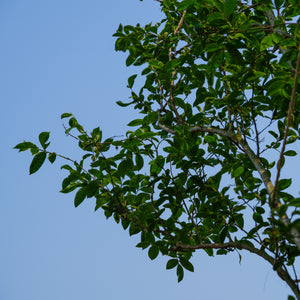
HOW TO USE
Crape Myrtles offer a wide range of landscape applications, from formal to casual designs. Their long bloom time and sculptural form make them especially effective as a centerpiece.
- Focal Points: Use larger cultivars like Lagerstroemia indica 'Natchez' or 'Muskogee' as striking anchor trees in lawns, near patios, or at the end of a garden path.
- Mixed Borders: Combine mid-sized varieties like Lagerstroemia indica 'Catawba' with colorful summer perennials such as Rudbeckia, Salvia, or Coreopsis for layered interest.
- Urban Plantings: Compact forms such as Lagerstroemia 'Enduring Red' or 'Rikki Tikki Rouge' are ideal for small gardens, foundation plantings, and containers.
- Privacy Screens: Plant Lagerstroemia indica 'Sioux' or 'Catawba' in a staggered row to create a flowering hedge that doubles as a visual barrier.
- Winter Interest: Bark texture and branch structure keep landscapes visually appealing through colder months.
The dramatic form and vibrant blooms of Crape Myrtles ensure they remain a reliable and eye-catching focal point in every season.
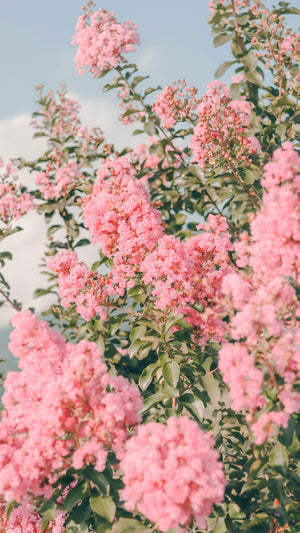
Common Questions
How to prune a crape myrtle tree? Prune in late winter to remove suckers, crossing branches, and spent flower heads. Light shaping is fine, but avoid aggressive cuts—never top the tree.
When do crape myrtles bloom? Most bloom from mid-to-late summer through early fall, depending on the cultivar and growing conditions.
How fast do crape myrtles grow? Growth rate varies by variety. Most grow 1–2 feet per year, with some dwarf types maturing faster.
When to prune crape myrtle? Prune in late winter while the tree is dormant. This encourages strong spring growth and abundant flowers.
How to propagate crape myrtle trees? Propagate by taking softwood cuttings in late spring or hardwood cuttings in winter. Rooting hormone improves success.
When to plant crape myrtle? Plant in spring or fall to avoid summer heat stress or winter root damage.
How big do crape myrtles get? Size depends on the cultivar. Dwarf types stay under 5 feet, while tree forms like 'Natchez' can reach 20–30 feet tall and wide.
Conclusion
Crape Myrtles are one of the most versatile and impactful ornamental trees for warm-climate gardens. With dazzling blooms, colorful bark, and drought tolerance, they provide four seasons of beauty. Whether you're planting a small-space variety like 'Enduring Red' or a statuesque favorite like 'Natchez', crape myrtles create stunning focal points that enrich your garden design and attract pollinators all summer long.
The Crape Myrtle Collection
Sold Out
Sold Out
Sold Out

